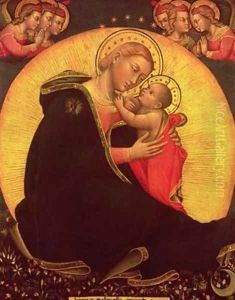Lippo di Dalmasio Paintings
Lippo di Dalmasio, also known as Lippo delle Madonne, was an Italian painter active during the late 14th and early 15th centuries, primarily in Bologna and its surroundings. Born around 1353, possibly in Bologna, Lippo di Dalmasio was part of a family of painters, which included his father, Dalmasio Scannabecchi, who was also his first teacher. Lippo's work is characterized by its devotional intensity, particularly in his depictions of the Madonna, earning him the nickname 'Lippo delle Madonne' (Lippo of the Madonnas).
His style is deeply rooted in the Gothic tradition, yet it also shows a tenderness and emotional intimacy that were innovative for his time. Lippo was influenced by the works of Vitale da Bologna and Simone dei Crocifissi, incorporating their use of vivid colors and gold leaf, but he also developed a distinctive style that emphasized the sweetness and grace of his religious subjects. His Madonnas are often shown with a gentle, melancholic expression, which became a hallmark of his work and greatly admired by his contemporaries.
Throughout his career, Lippo di Dalmasio remained active in Bologna, though documents also link him to Pistoia in 1388, suggesting that his work was sought after beyond his native city. He contributed significantly to the artistic landscape of Bologna, executing altarpieces, frescoes, and panel paintings for various churches and patrons. One of his most famous works is the 'Madonna dei Denti' (Madonna of the Teeth), which showcases his ability to convey maternal affection and divine grace.
Despite his contributions to the development of Bolognese painting, Lippo di Dalmasio's work was somewhat overshadowed by the emergence of the Renaissance style. However, his paintings continued to be revered for their devotional quality and craftsmanship. Lippo di Dalmasio's legacy includes not only his influence on the generation of artists that followed but also a considerable body of work that still attracts admiration for its beauty and emotional depth. He is believed to have died around 1410, leaving behind a legacy that encapsulates the transition from Gothic to early Renaissance art in northern Italy.
